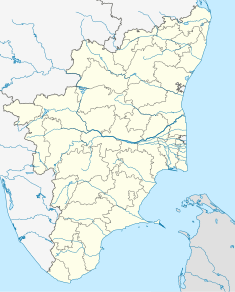Tiruchirappalli Fort
This article needs additional citations for verification. (November 2018) |
| Tiruchirappalli Fort (Trichinopoly Fort) | |
|---|---|
Trichirapalli, India | |
| Coordinates | 10°48′18″N 78°41′06″E / 10.805°N 78.685°E |
| Elevation | 88m above Sea level |
| Current use | Ruins |
| Architectural style(s) | Dravidian architecture (Nayakkar of Madurai) |
Tiruchirappalli Fort is a dilapidated fort in India which once protected the Old City of Trichy encompassing Big Bazaar Street, Singarathope, Bishop Heber School, Teppakulam and
Strategically sited on the bank of the River Cauvery (Kaveri) in Southern India, about 56 miles (90 km) from the sea, Trichinopoly was the third most important fortified post in the Madras Presidency (after
Origin of the Tiruchirappalli Fort
The greater part of the fort of Tiruchirappalli and most of the city was built in the reign of Viswanatha Nayaker, King of Madurai, from 1559. His grandson, Chokkanatha Nayaker, was responsible for making it the kingdom's capital. In the mid-eighteenth century the city was a frequent centre of conflict between French and British forces in the struggle to control Southern India. The city also suffered attacks during the Mysore Wars of the second half of the century, when it was devastated more than once.
Structures inside the fort complex
Origin of Rock Fort
The Rock is said to be one of the oldest formations in the world. It is 3.8 billion years old, making it as old as the rocks in Greenland and older than the Himalayas.[1] Quartz, used in glass making, and feldspar, used in ceramics, are found in this rock formation. It is also the highest and the largest single rock on Earth that is a tourist attraction.
Constructions
As the name suggests, the Rock Fort
Temple Complex
The temple complex in the fort complex is a collection of three temples:
- the Manikka Vinayakar temple at the foot of the hill, dedicated to Lord Ganesha
- the Ucchi Pillayar Templeat the top of the hill, dedicated to Lord Ganesha
- the Taayumaanavar Koyil Shivastalam, a rock cut temple dedicated to a Nayaka era saint, Taayumaanavar
Mathrubutheswarar, dedicated to Lord
Rock-Cut Temple
The rock-cut temple in the hill temple complex was built during the
Tank
At the foot of the rock fort stands a tank and a pavilion which are used during the float festival of the temples. These were by Viswanatha Naicker of Madurai to hold major religious festivals.
Near the tank is the house and 18th-century Church of Our Lady of Lourdes built by Reverend Schwartz of Denmark.
Mosque
Mosque built by Nawab of Arcot lays perpendicular to Clives Hostel facing the Tank.
English Quarters
Presently called Clives Hostel was once quarters which housed the English Soldiers and their Commander Robert Clive
Palace
The mid-17th-century palace at the base of the rock was built by Chokkanatha Naicker, now known as Rani Mangammal Mahal or Town Hall, and features a Durbar hall. Historians thought the palace was built by Chokkanatha Naicker after he demolished three-fourths of the Thirumalai Naicker palace. This palace was supposedly used as a Warehouse in this palace. This palace was also the Durbar hall of Madurai Naickers when Tiruchapalli was the capital during the years 1616 to 1634 and 1665 to 1736. Today, it houses a museum, Fort Police Station and state government offices like Taluka Office.
Main Guard Gate
The main guard gate was one of the main entrances for the fort complex. It is located on the major fort wall enclosing the periphery of the rock fort with its temples, lake, the palace and bazaars. The main entrance faces the north.
Major battles
Nayak era
As the Fort was the capital of the
Carnatic Nawab Era
During the mid century,
British Era
In the late 18th century, Hyder Ali and Tipu Sultan were a major threat to the British, as were the French who were still fighting for their colonial supremacy in this region. By now, the town was firmly established as a Cantonment town and the fort's gate was known as Main Guard Gate.Robert Clive lived near the tank when he was in Tiruchirappalli at the Clives Lodge facing Temple Tank . Today Clives Lodge houses many Book Depots and Hotel Vasantha Bhavan.
10°49′31″N 78°41′21″E / 10.825334°N 78.689103°E
References
- ISBN 978-0-470-55610-8
See also
- Fort St George
- Fort St David
- Siege of Trichinopoly (1751–1752)

